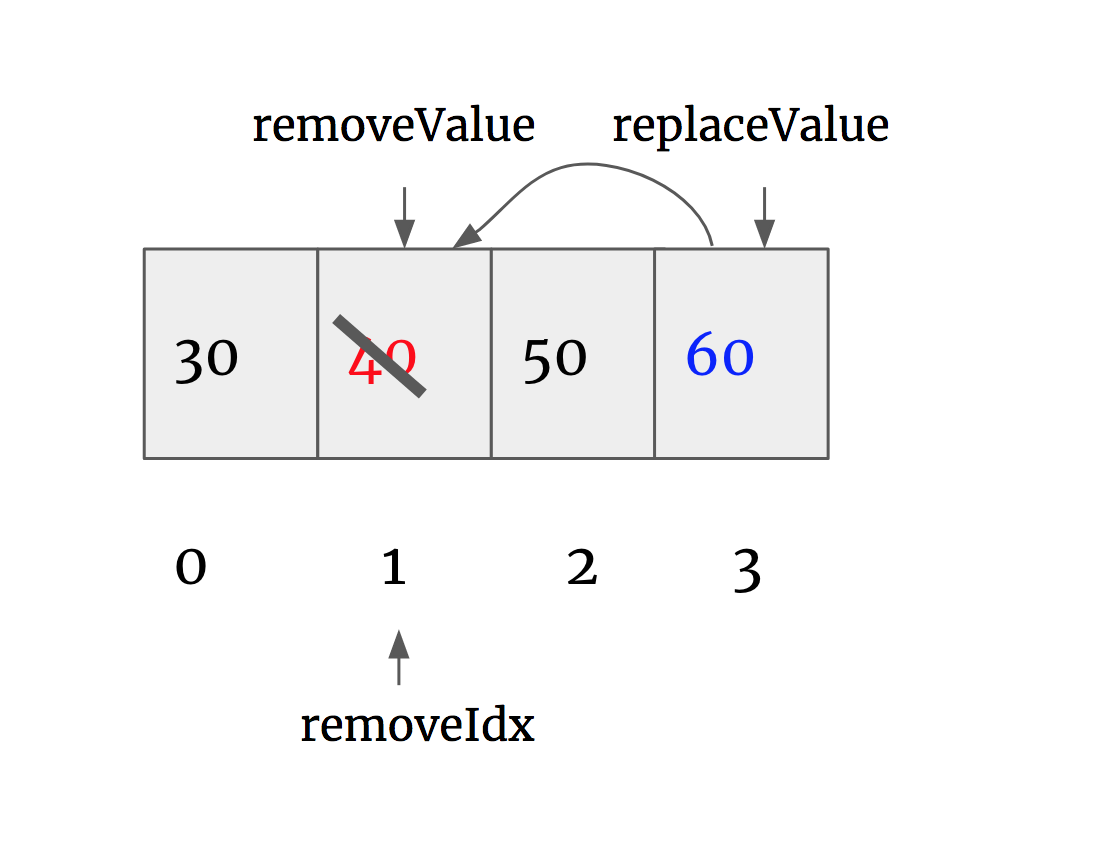[leetcode]380. Insert Delete GetRandom O(1)常数时间插入删除取随机值
Design a data structure that supports all following operations in average O(1) time.
insert(val): Inserts an item val to the set if not already present.remove(val): Removes an item val from the set if present.getRandom: Returns a random element from current set of elements. Each element must have the same probability of being returned.
Example:
// Init an empty set.
RandomizedSet randomSet = new RandomizedSet(); // Inserts 1 to the set. Returns true as 1 was inserted successfully.
randomSet.insert(1); // Returns false as 2 does not exist in the set.
randomSet.remove(2); // Inserts 2 to the set, returns true. Set now contains [1,2].
randomSet.insert(2); // getRandom should return either 1 or 2 randomly.
randomSet.getRandom(); // Removes 1 from the set, returns true. Set now contains [2].
randomSet.remove(1); // 2 was already in the set, so return false.
randomSet.insert(2); // Since 2 is the only number in the set, getRandom always return 2.
randomSet.getRandom();
Solution1: HashMap + ArrayList
1. use an ArrayList together with HashMap, making hashmap save key(item)->value(idx)
2. To reverse item in O(1), avoiding traversal the whole arrayList in O(n) time, we swap the toDelete item with last item in the list
3. Go through an example like this:

use HashMap to get removeIdx:

Set the last item in the list as replaceValue, why the last item? In order to maintain other indices.

Deal with HashMap: (1) put (2)delete

Deal with List: (1) set (2)delete

code:
class RandomizedSet {
Map<Integer, Integer> map;
List<Integer> list;
Random r; // java 自带类
/** Initialize your data structure here. */
public RandomizedSet() {
list = new ArrayList<>();
map = new HashMap<>();
r = new Random();
}
/** Inserts a value to the set. Returns true if the set did not already contain the specified element. */
public boolean insert(int val) {
if (map.containsKey(val)) {
return false;
}
map.put(val, list.size());
list.add(val);
return true;
}
/** Removes a value from the set. Returns true if the set contained the specified element. */
public boolean remove(int val) {
/**
hashmap
30 - 0
40 - 1
50 - 2
60 - 3
list: 30 40 50 60
0 1 2 3
**/
if (!map.containsKey(val)) return false;
int removeIdx = map.get(val); // Idx: 1
int replaceValue = list.get(list.size()-1); // replaceValue : 60
// deal with map
map.put(replaceValue, removeIdx);
map.remove(val);
// deal with list
list.set(removeIdx, replaceValue);
list.remove(list.size() -1);
return true;
}
/** Get a random element from the set. */
public int getRandom() {
return list.get(r.nextInt(list.size()));
}
}
[leetcode]380. Insert Delete GetRandom O(1)常数时间插入删除取随机值的更多相关文章
- [LeetCode] 380. Insert Delete GetRandom O(1) 常数时间内插入删除和获得随机数
Design a data structure that supports all following operations in average O(1) time. insert(val): In ...
- LeetCode 380. Insert Delete GetRandom O(1) 常数时间插入、删除和获取随机元素(C++/Java)
题目: Design a data structure that supports all following operations in averageO(1) time. insert(val): ...
- [leetcode]381. Insert Delete GetRandom O(1) - Duplicates allowed常数时间插入删除取随机值
Design a data structure that supports all following operations in average O(1) time. Note: Duplicate ...
- [LeetCode] 381. Insert Delete GetRandom O(1) - Duplicates allowed 插入删除和获得随机数O(1)时间 - 允许重复
Design a data structure that supports all following operations in average O(1) time. Note: Duplicate ...
- [LeetCode] Insert Delete GetRandom O(1) 常数时间内插入删除和获得随机数
Design a data structure that supports all following operations in average O(1) time. insert(val): In ...
- [LeetCode] 380. Insert Delete GetRandom O(1) 插入删除获得随机数O(1)时间
Design a data structure that supports all following operations in average O(1) time. insert(val): In ...
- LeetCode 380. Insert Delete GetRandom O(1)
380. Insert Delete GetRandom O(1) Add to List Description Submission Solutions Total Accepted: 21771 ...
- leetcode 380. Insert Delete GetRandom O(1) 、381. Insert Delete GetRandom O(1) - Duplicates allowed
380. Insert Delete GetRandom O(1) 实现插入.删除.获得随机数功能,且时间复杂度都在O(1).实际上在插入.删除两个功能中都包含了查找功能,当然查找也必须是O(1). ...
- LeetCode 380. Insert Delete GetRandom O(1) (插入删除和获得随机数 常数时间)
Design a data structure that supports all following operations in average O(1) time. insert(val): In ...
随机推荐
- Java_IO异常处理方式_入门小笔记
package IO; import java.io.FileWriter; import java.io.IOException; /** * IO异常处理方式 */ class FileWrite ...
- BSS, DATA, TEXT, HEAP, STACK
BSS, block start segment, static memory, to store the global data which are not initialized. DATA, d ...
- 第2章 Java基本语法(上): 变量与运算符
2-1 关键字与保留字 关键字(keyword) 保留字(reserved word) 2-2 标识符(Identifier) 案例 class Test{ public static void ma ...
- ILBC 规范
本文是 VMBC / D# 项目 的 系列文章, 有关 VMBC / D# , 见 <我发起并创立了一个 VMBC 的 子项目 D#>(以下简称 <D#>) https://w ...
- 各CF-based tracker中output_sigma_factor取值
现有的各CF-Based tracker中理想高斯响应中output_sigma_factor的取值情况 默认output_sigma = target_sz*output_sigma_factor; ...
- HTTP各种特性
一.Http客户端 1.浏览器.打开百度首页 2.Curl工具 二.CORS 跨域(浏览器的功能) 1.修改Server.js const http = require('http'); const ...
- Redis 总结精讲 看一篇成高手系统-4
本文围绕以下几点进行阐述 1.为什么使用redis2.使用redis有什么缺点3.单线程的redis为什么这么快4.redis的数据类型,以及每种数据类型的使用场景5.redis的过期策略以及内存淘汰 ...
- sourcetree file status checkbox gone (文件状态下的勾选文件 list 消失)
原来是这样的(sourcetree 版本 2.7.1) 不知道触发了什么条件,sourcetree 变成了以下状态(官方解释是拖动面板小于 1 px 后会导致这个问题) 中间的那一列可勾选的已修改的文 ...
- 黄聪:详解申请微信h5支付方法,开通微信h5网页支付接口(转)
版权声明:图文并茂的微信小程序教程!欢迎转载,请保留作者名字和链接:商业合作请联系子恒老师助理 QQ : 2334512685 https://blog.csdn.net/towtotow/artic ...
- node升级的正确方法
本文主要是针对安装了node的用户如何对node进行升级或者安装指定版本:没有安装node的可以参考连接node安装方法 . 安装方法: 1.产看node版本,没安装的请先安装: $ node -v ...
